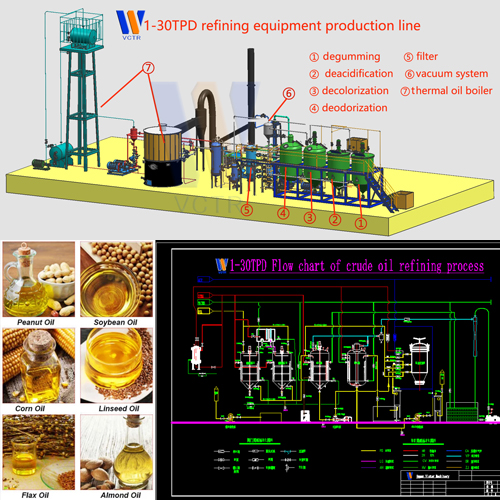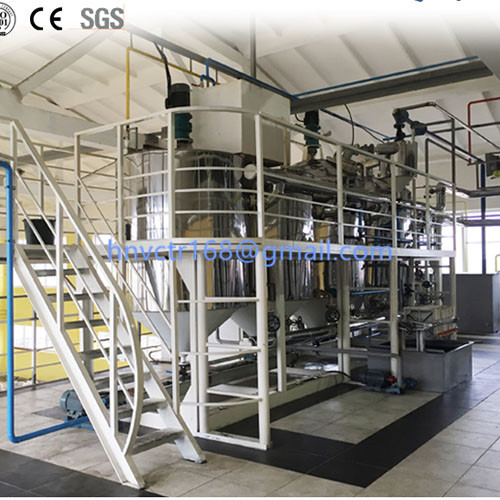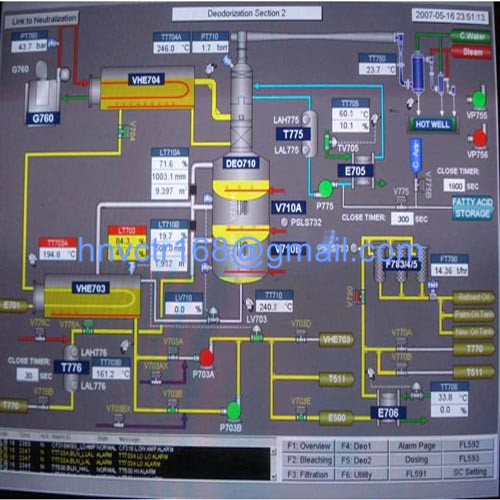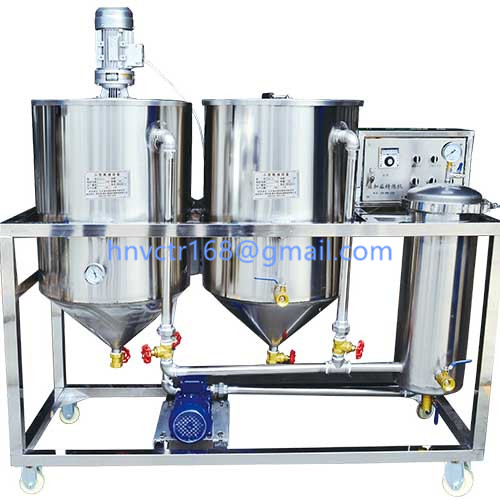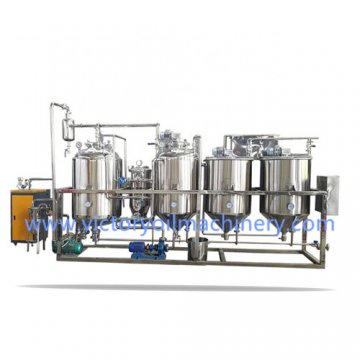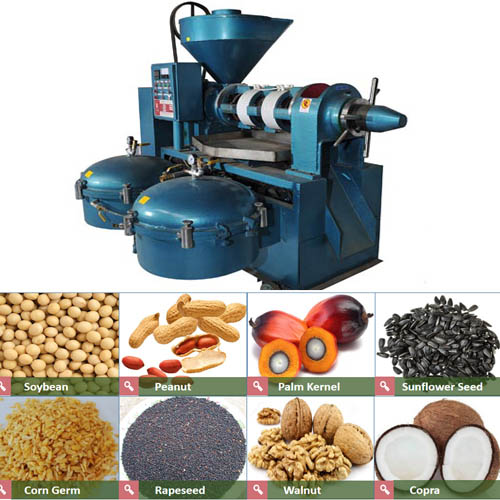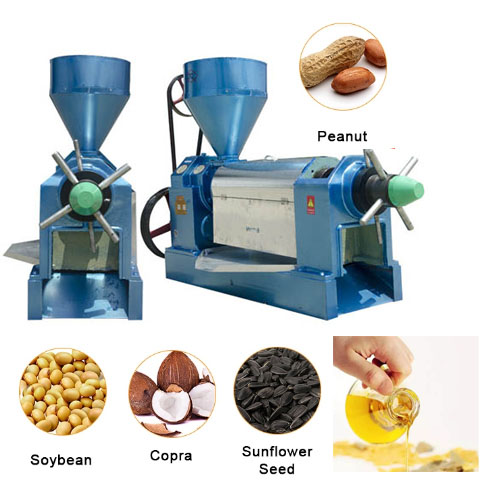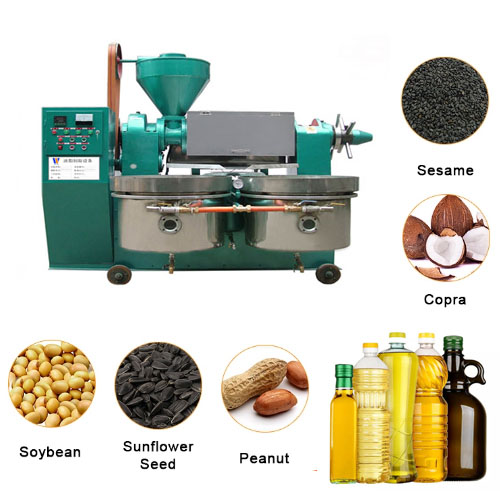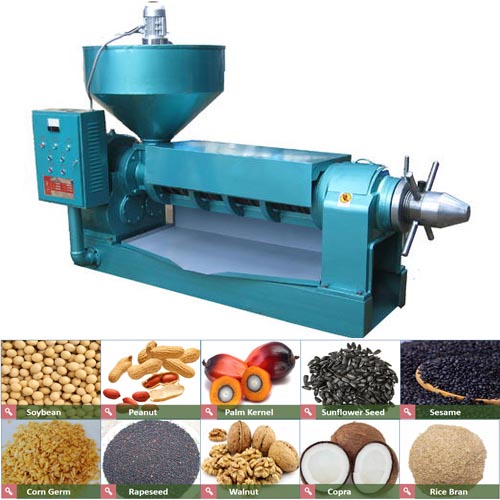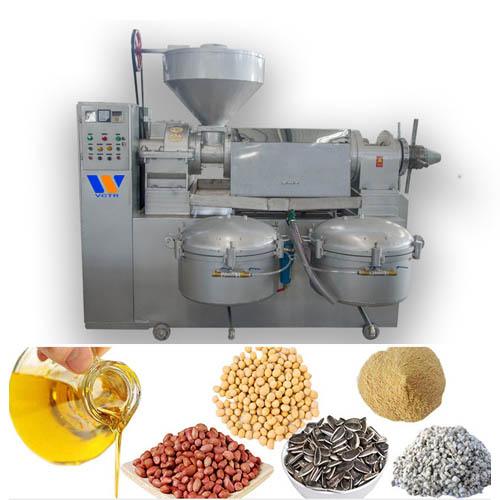Oil refining-Desolventizing
1. Principle of desolventizing
Due to the wide boiling range of No. 6 mineral spirits (60~90℃) and its complicated composition, although the solvent in the mixed oil is recovered by evaporation and stripping, the high boiling point components remaining in the oil are still difficult to remove. As a result, the residual solubility in the extracted crude oil is higher. The operation of removing the residual solvent in the extracted oil is called "desolventizing". The residual amount of solvent in the oil after desolventizing should not exceed 50 mg/L.At present, the most widely used method at home and abroad is the steam distillation desolventizing method. The principle is that when water vapor passes through the extraction of crude oil, the vapor-liquid surface contacts, and the water vapor is saturated by the volatilized solvent and escapes according to its partial pressure ratio. So as to remove the solvent in the extracted oil. Because the volatility of solvents and fats are very different, steam distillation can remove volatile solvents from almost involatile fats.Desolventizing is carried out at a higher temperature. At the same time, it is equipped with a higher vacuum condition, the purpose of which is to increase the volatility of the solvent: only protect the oil from being oxidized at high temperatures; reduce the consumption of steam.
2. Desolventizing process
1) Bacth desolventizing process
Extracted oil after hydration or alkali refining → desolventizing → cooling → refined oil.
2) Operation steps
Step 1: Start the vacuum pump to stabilize the vacuum of the desolventizing system at about 7000 Pa, and suck the extracted oil into the desolventizing pot, and the amount of oil filled is about 60% of the capacity of the pot.
Step 2: Turn on indirect steam to raise the oil temperature to 100°C. Direct steam with a pressure of about 0.1 MPa is used to fully turn the oil in the pot, and continue to use indirect steam to raise the oil temperature to 140°C. At the same time, it will be timed to start desolventizing.
Step 3: Depending on the quality of the extracted oil, the desolventizing time is generally about 4 hours, during which the oil temperature is maintained at 140°C and the vacuum degree is about 8000 Pa.
Step 4: Turn off the indirect steam 0.5 hours before the end of desolventizing, and turn off the direct steam only after the specified time.
Step 5: Pass the desolubilized oil through a cooler, or cool it to 70°C in the pot, then break the vacuum, and release the finished oil.
3) Desolventizing equipment
Desolventizing equipment is called desolventizing pot when used for desolventizing. The shell is a vertical cylinder, the top and bottom are a dish-shaped head; the top cover has a steam drum to maintain a certain vaporization space, and the lighting and peeping lights are arranged at 180 degrees to facilitate the observation of the situation in the pot; The top of the pot is equipped with a foam baffle to reduce the splash loss of oils and fats; there are two rows of snake pipes in the pot, which can be indirectly steamed to heat the grease or water to cool the oils and fats; The bottom of the pot is equipped with a direct steam dispersing plate, which has many small holes to make direct steam spray into the oil;There is also a circulation tube in the center of the desolventizing pot, and direct steam is ejected through the nozzle, so that the oils and steam in the circulation tube rises strongly along the circulation tube in the form of an emulsion, and the oils and fats is sprayed on the upper part of the desolventizing pot full of steam. The solvent is more volatile and removed. At the same time, this device also strengthens the circulation of the oils and fats in the pot. In addition, there are holes and various takeovers on the shell of the desolventizing pot.
4) Other auxiliary equipment
Other auxiliary equipment includes W-type mechanical vacuum pump or steam-water series jet pump, atmospheric condenser, air balancing tank and Liquid foam capturer, etc.
5) Continuous desolventizing process
Extracted oil after hydration or alkali refining → heater → desolventizing pot (→ vacuum system) → cooler → filtration → refined oil.
Hot tags:Desolventizing,Desolventizing process,Bacth desolventizing process,Desolventizing equipment,desolventizing pot,Continuous desolventizing process
Due to the wide boiling range of No. 6 mineral spirits (60~90℃) and its complicated composition, although the solvent in the mixed oil is recovered by evaporation and stripping, the high boiling point components remaining in the oil are still difficult to remove. As a result, the residual solubility in the extracted crude oil is higher. The operation of removing the residual solvent in the extracted oil is called "desolventizing". The residual amount of solvent in the oil after desolventizing should not exceed 50 mg/L.At present, the most widely used method at home and abroad is the steam distillation desolventizing method. The principle is that when water vapor passes through the extraction of crude oil, the vapor-liquid surface contacts, and the water vapor is saturated by the volatilized solvent and escapes according to its partial pressure ratio. So as to remove the solvent in the extracted oil. Because the volatility of solvents and fats are very different, steam distillation can remove volatile solvents from almost involatile fats.Desolventizing is carried out at a higher temperature. At the same time, it is equipped with a higher vacuum condition, the purpose of which is to increase the volatility of the solvent: only protect the oil from being oxidized at high temperatures; reduce the consumption of steam.
2. Desolventizing process
1) Bacth desolventizing process
Extracted oil after hydration or alkali refining → desolventizing → cooling → refined oil.
2) Operation steps
Step 1: Start the vacuum pump to stabilize the vacuum of the desolventizing system at about 7000 Pa, and suck the extracted oil into the desolventizing pot, and the amount of oil filled is about 60% of the capacity of the pot.
Step 2: Turn on indirect steam to raise the oil temperature to 100°C. Direct steam with a pressure of about 0.1 MPa is used to fully turn the oil in the pot, and continue to use indirect steam to raise the oil temperature to 140°C. At the same time, it will be timed to start desolventizing.
Step 3: Depending on the quality of the extracted oil, the desolventizing time is generally about 4 hours, during which the oil temperature is maintained at 140°C and the vacuum degree is about 8000 Pa.
Step 4: Turn off the indirect steam 0.5 hours before the end of desolventizing, and turn off the direct steam only after the specified time.
Step 5: Pass the desolubilized oil through a cooler, or cool it to 70°C in the pot, then break the vacuum, and release the finished oil.
3) Desolventizing equipment
Desolventizing equipment is called desolventizing pot when used for desolventizing. The shell is a vertical cylinder, the top and bottom are a dish-shaped head; the top cover has a steam drum to maintain a certain vaporization space, and the lighting and peeping lights are arranged at 180 degrees to facilitate the observation of the situation in the pot; The top of the pot is equipped with a foam baffle to reduce the splash loss of oils and fats; there are two rows of snake pipes in the pot, which can be indirectly steamed to heat the grease or water to cool the oils and fats; The bottom of the pot is equipped with a direct steam dispersing plate, which has many small holes to make direct steam spray into the oil;There is also a circulation tube in the center of the desolventizing pot, and direct steam is ejected through the nozzle, so that the oils and steam in the circulation tube rises strongly along the circulation tube in the form of an emulsion, and the oils and fats is sprayed on the upper part of the desolventizing pot full of steam. The solvent is more volatile and removed. At the same time, this device also strengthens the circulation of the oils and fats in the pot. In addition, there are holes and various takeovers on the shell of the desolventizing pot.
4) Other auxiliary equipment
Other auxiliary equipment includes W-type mechanical vacuum pump or steam-water series jet pump, atmospheric condenser, air balancing tank and Liquid foam capturer, etc.
5) Continuous desolventizing process
Extracted oil after hydration or alkali refining → heater → desolventizing pot (→ vacuum system) → cooler → filtration → refined oil.
Hot tags:Desolventizing,Desolventizing process,Bacth desolventizing process,Desolventizing equipment,desolventizing pot,Continuous desolventizing process

